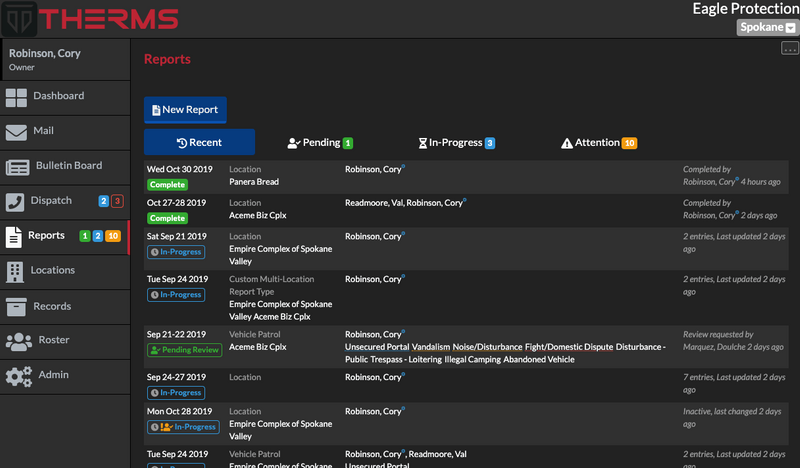Reports can be many different collections of information from DAR logs, incident reports, violations, security shift activity, to disciplinary action, vehicle maintenance logs, and much more. Reports are fully customizable with a drag and drop builder to make any type of Report your organization needs.
If you are new to THERMS and have not yet completed the basic Report module setup, checkout this tutorial Reports Setup
Security reports are used across the industry in every facet of security guard services and private protection. THERMS defines a Report as a document that's filled out and completed by one or more security officers to contain info of who, what, where, when, why, how. These are important details that every security officer on shift should include in a Report that can be saved and even passed on via email or pdf file to interested parties.

Concept & Definitions
A Report in the THERMS app is a document of information that is entered by one or more users. The Report is a central location for documenting info such as a security officer's shift and activity (D.A.R.), a vehicle accident, camera monitoring activity, employee discipline, etc..
A Report is a document with information that is entered by one or more users
A Report has a Report Type which defines the name of the Report as well as some other configurable information. There are built-in Report Types and you can create as many custom Report Types as you need. Report Types can be configured to allow different optional information such as whether or not a User can manually edit the date of the Report, if a Report requires to be reviewed before before completed, and more.
A Report Type is a "type" of Report and defines the name, settings & rules of the Report

Every Report will have 1 or more Report Entries that make up the information added to the Report. A Report Entry has fields like date input, text entry, checkboxes and files input for a User to add information. Every Report Type has different Report Entry types that are allowed to be used in the Reports. This is configurable in the Report module config menu. There are dozens of pre-built Report Entry types already available in THERMS and you can create as many custom Report Entries as your organization needs.

The Report Process
There is a flow that Reports go through, a.k.a. "report lifecycle". A Report is created, Users add information with Report Entries, it's submitted/completed and then in most cases emailed to subscribers.
Different Report States
Reports have several different states: In-Progress, Pending Review, Review Rejected, Complete, & Re-Opened. When a Report is first created, it's state is In-Progress.
A Report can only be edited/changed when it is In-Progress, Review Rejected or Re-Opened
After the Report is completed with information from User(s) it can be moved to Pending Review or Complete, depending on the Report Type config and User permissions. When a Report is Pending Review, any User with the permissions to "Review & Approve Reports" can review the Report; if the Report is unsatisfactory or needs changes, it can be rejected with a note to the author(s) of the Report which moves the Report to the state of Review Rejected. The other option when reviewing a Pending Review Report is to approve which moves the Report to the Completed state.
Adding Report Entries
When a Report is In-Progress or editable, Users can add Report Entries. There are built-in as well as custom Report Entries built for your organization that the User can pick from:

After the User selects a Report Entry type, they will add information the Report Entry and save it:


Completing a Report
Once a Report is finished, there is no more information to add to it, a User can hit the "Complete" button. Depending on the Report Type configuration and if the Report requires a "Review & Approve" step or the User has the permission to "Review & Approve Reports", the User may see 2 different buttons when clicking "Complete".


Completing & Reviewing Pending Reports
The step where a Report is submitted for review is an option that every Report Type can have. If a Report Type is configured with "Requires Review & Approval", then any User that does not have the permissions to "Review & Approve Reports" will only be able to create a Report then move to Request Review state. These Reports can be reviewed by the Users with the appropriate permissions. If the Report is unsatisfactory or needs changes, it can be rejected with a note to the author(s) of the Report which moves the Report to the state of Review Rejected. The other option when reviewing a Pending Review Report is to approve which moves the Report to the Completed state.
The reason for this review step is built into THERMS is to give organizations the opportunity to review their User's Reports for spelling, grammar, inconsistencies, missed information, or request additional information, before they're saved or sent to customers, management, law enforcement, etc..
If a Report Type does not require review before being completed, then it can simply be moved to "Complete" when the User is finished adding information to the Report.
Emailed Reports
Reports can be setup to be emailed automatically if they are assigned to a Location that has Location Subscribers setup. Immediately when a Report is moved to the Complete state, it is emailed. This means for Report Types that require review , they won't be emailed until they're approved and marked Complete by a User with the appropriate permissions.

